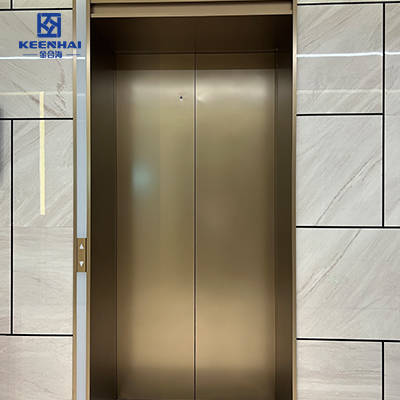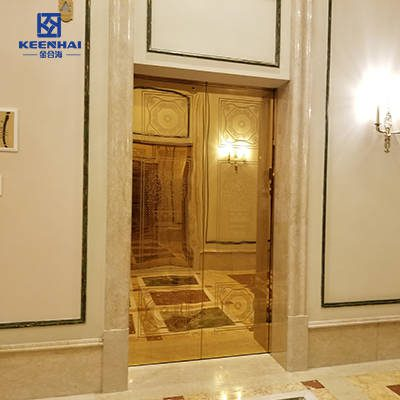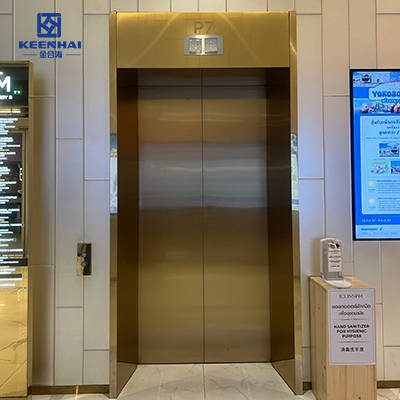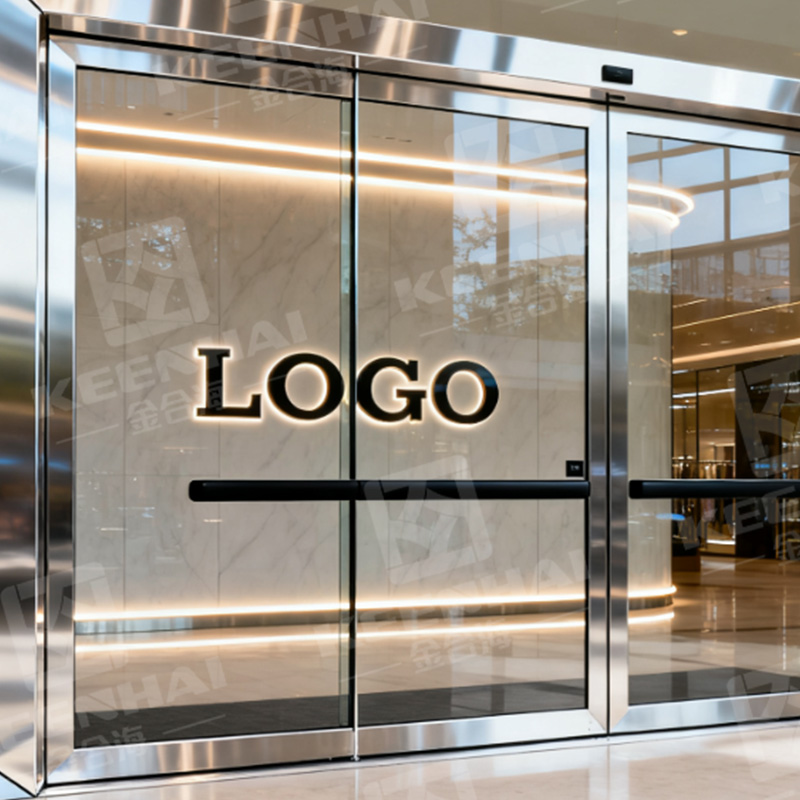Customization options make a huge difference in style and functionality. Choose a manufacturer who offers PVD color coatings, etched patterns, and integration with interior architecture. This approach ensures doors reflect your brand and design intent while withstanding heavy use. Visiting past installations and reviewing case studies lets you see real performance, making the investment in a high-quality Elevator Door | PVD Stainless Steel worthwhile.
1.Why Choosing the Right Manufacturer Matters
Choosing the right custom elevator door manufacturer isn’t just a checkbox in your project plan—it determines how well your design integrates with the building, how long the doors last, and how safe they remain under heavy daily use. A poorly chosen manufacturer can create delays, increase costs, and compromise your project’s overall aesthetics.
1.1Design Integration
Every building has a unique style, whether it’s a luxury hotel lobby, a modern office tower, or a bustling shopping mall. Custom elevator doors must match the interior architecture seamlessly, from wall finishes to lighting reflections. For example, a hotel in Singapore used brushed stainless steel doors with PVD bronze accents to complement its marble walls and warm lighting, creating a cohesive and luxurious entrance experience. Choosing the wrong manufacturer can lead to mismatched textures, off-tone finishes, or doors that simply don’t fit the intended design.
1.2Durability and Safety
High-traffic areas demand materials that can withstand constant use. 304 or 316 stainless steel, combined with precise fabrication and quality finishes, ensures doors maintain structural integrity and aesthetic appeal for years. In a Dubai shopping mall project, using a reliable manufacturer prevented early dents, scratches, and surface discoloration, which would have otherwise caused frequent maintenance costs. Safety is equally critical—doors must operate smoothly without risk of jams or malfunctions, especially in hospitals or high-rise offices.
1.3Impact on Cost and Timeline
Choosing the right manufacturer upfront saves time and money. Here’s how poor selection can affect your project:
-
Misaligned measurements requiring re-fabrication
-
Delays due to low production capacity or slow delivery
-
Extra costs from substandard materials or finishes
-
Increased maintenance or early replacement
Conversely, working with a professional manufacturer ensures accurate CAD-based design, timely production, and high-quality materials from day one. This approach reduces unexpected expenses and keeps the project on schedule.
1.4Real Project Example
A five-star hotel in New York collaborated with a trusted manufacturer to deliver gold PVD-coated stainless steel doors with etched patterns. The doors were completed on time, integrated perfectly with the lobby design, and required minimal maintenance even after years of heavy use. This highlights why selecting the right partner matters more than any other single decision in elevator door procurement.
A high-quality manufacturer doesn’t just supply doors—they become a part of your building’s identity, performance, and long-term value. Choosing wisely impacts every stage, from design harmony to safety and budget control.

2.Key Criteria to Evaluate a Custom Elevator Door Manufacturer
Selecting a custom elevator door manufacturer requires more than checking prices. The right partner guarantees doors that look great, last long, and operate safely in high-traffic environments. Here’s what really matters:
2.1Experience and Portfolio
A manufacturer’s track record speaks volumes. Look for companies that have completed projects similar to yours, whether it’s a luxury hotel, corporate office tower, or busy shopping mall. Visiting completed installations or reviewing detailed case studies helps you judge craftsmanship, attention to detail, and finish quality. For instance, a New York luxury apartment worked with a manufacturer that had prior experience in gold PVD coatings and etched stainless steel patterns. The result was doors that fit perfectly and elevated the lobby’s overall look.
2.2Material Expertise
The choice of material impacts durability, safety, and maintenance. Top manufacturers work with 304 and 316 stainless steel, tempered glass, and advanced PVD coatings. Understanding the difference matters:
| Материјал | Best For | Benefits |
|---|---|---|
| 304 Stainless Steel | Hotels, offices | Polished look, cost-effective, moderate corrosion resistance |
| 316 Stainless Steel | Hospitals, coastal buildings | High corrosion resistance, heavy-duty durability |
| PVD Coatings | Luxury projects | Wide color options, scratch-resistant finish |
Manufacturers that understand these nuances can guide you to the right combination of material and finish, ensuring doors last decades even in busy settings.
2.3Manufacturing Capabilities
Precision and customization define quality. Ensure the manufacturer uses CAD drawings, precise cutting, carving, polishing, and coating. Here’s a typical workflow they should follow:
-
Confirm project requirements and design goals
-
Create CAD drawings and simulate door dimensions
-
Cut and shape stainless steel panels accurately
-
Apply polishing, PVD, or etched designs
-
Conduct pre-delivery quality checks
A capable manufacturer prevents misalignments, finish errors, or delivery delays. For example, a Dubai hotel installed gold PVD doors with etched geometric patterns. The CAD confirmation ensured doors fit tight spaces perfectly, without last-minute modifications.
2.4Quality Control Procedures
Quality checks are critical. The best manufacturers inspect every door for finish consistency, structural integrity, and smooth operation. Some even conduct stress tests that mimic years of usage. In a Singapore mall project, thorough quality checks prevented dents, scratches, and operational failures despite heavy daily traffic.
2.5Communication and Support
Finally, a manufacturer should be easy to communicate with. Clear, responsive communication ensures your design intent is fully understood and minimizes errors. Quick responses to questions about finishes, measurements, or installation schedules often differentiate top-tier manufacturers from average ones.
Practical Tip: Before signing, request references, view sample projects, and check if the manufacturer can accommodate last-minute adjustments or specific design requests. Real-world performance is the best proof of reliability.
Evaluating experience, material expertise, manufacturing capability, quality control, and communication ensures your Elevator Door | PVD Stainless Steel investment delivers long-term value, safety, and visual impact. Spending time on this upfront saves headaches, costs, and design compromises later.

3.Comparing Manufacturers: What to Look For
Приликом поређења custom elevator door manufacturers, you need more than a brochure or a price tag. The right choice impacts timelines, installation quality, and long-term maintenance costs. Here’s a practical way to evaluate:
| Criteria | Top Manufacturer | Mid-Tier Manufacturer | Low-Cost Manufacturer | Notes |
|---|---|---|---|---|
| Delivery Time | Flexible, can handle rush orders | Standard schedule, minor adjustments possible | Long lead time, limited flexibility | Flexibility saves project delays |
| After-Sales Service & Warranty | 3–5 years, on-site support, replacement parts | 1–2 years, limited support | Minimal or no warranty | Longer warranty reduces maintenance stress |
| Installation Guidance | CAD-based instructions, on-site technician | Standard instructions, phone support | Basic instructions only | On-site guidance prevents errors |
| Material & Finish Options | 304/316 stainless steel, PVD, etched/carved patterns | Limited finishes, mostly 304 steel | Very basic materials and finishes | More options = better design integration |
| Price vs Value | Slightly higher, long-term savings | Moderate | Cheapest upfront, higher future costs | Balance cost with quality and durability |
3.1Delivery Time and Flexibility
Projects often run on tight schedules. Top manufacturers adjust production stages for urgent requests without compromising quality. For example, a Dubai hotel needed gold PVD doors quickly. The manufacturer delivered on time, keeping the lobby opening schedule intact.
3.2After-Sales Service and Warranty
Even premium doors occasionally need attention. Top manufacturers provide proactive maintenance checks, replacement parts, and on-site support. A Singapore office tower had 316 stainless steel doors that stayed flawless under heavy daily traffic thanks to a 5-year warranty and proactive guidance.
Installation Support
The right manufacturer guides your team step by step:
-
Provide CAD-based installation diagrams
-
Send an on-site technician for guidance
-
Inspect alignment, finish, and operation
-
Address adjustments immediately
When comparing manufacturers, score each based on timeline, warranty, installation support, and material options. This table helps make decisions clear, avoiding surprises and ensuring your Elevator Door | PVD Stainless Steel performs as intended.

4.Design Options and Customization Flexibility
When selecting custom elevator doors, your choices go beyond standard sizes. Design options and customization flexibility directly impact the visual appeal, brand identity, and integration with the building’s interior. Here’s what to consider:
4.1Polished vs. Brushed Stainless Steel
The finish affects both aesthetics and maintenance. Polished stainless steel delivers a mirror-like, high-end look, ideal for hotel lobbies or luxury apartments, but it shows fingerprints more easily. Brushed stainless steel provides a subtle, modern texture that hides minor scratches and smudges, making it suitable for high-traffic office towers or malls. For example, a luxury Dubai apartment combined brushed 304 stainless steel doors with polished accents to create depth and elegance.
4.2PVD Coating Colors
PVD coatings expand color options beyond standard steel. Gold, bronze, or black finishes allow doors to complement the building’s interior design. Each color requires precise coating processes to ensure uniformity and durability. In one New York hotel, the elevator doors featured black PVD coating that perfectly matched the marble and wood lobby finishes, creating a seamless and sophisticated look.
4.3Etched or Carved Patterns
Custom patterns allow branding, thematic designs, or unique architectural statements. Carved or etched stainless steel adds texture and visual interest while maintaining durability. A Singapore office tower used etched geometric patterns to echo the building’s modern façade. This approach allowed the Elevator Door | PVD Stainless Steel to act as both functional hardware and a design centerpiece.
4.4Integration with Interior Architecture
Customization ensures doors align with the overall interior style, from contemporary minimalism to classical luxury. Proper integration considers ceiling height, wall finishes, lighting, and furniture layout. Architects and manufacturers collaborate closely, using CAD drawings and mockups, to ensure that doors not only operate smoothly but also enhance the spatial experience. For example, a boutique hotel in London used custom-carved bronze PVD doors that matched the lobby’s warm-toned wood panels and pendant lights, creating a cohesive aesthetic.
Practical Tip: When planning your elevator doors, combine material, finish, pattern, and architectural integration choices early in the design process. Doing so avoids costly adjustments later and guarantees doors that perform beautifully while reflecting the building’s identity.
Bottom line: Flexibility in design and customization allows your elevator doors to stand out visually, function seamlessly, and enhance the overall architecture. Investing in a manufacturer that can deliver these options ensures your Elevator Door | PVD Stainless Steel meets both aesthetic and functional goals.
Evaluation done? See certified, warranty-backed solutions in our custom elevator door portfolio and request samples today.






